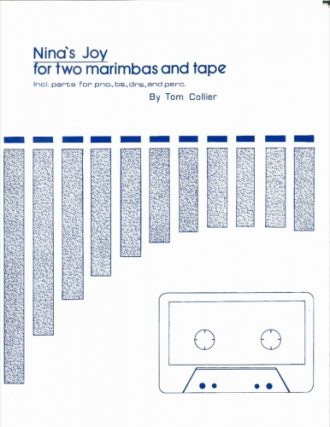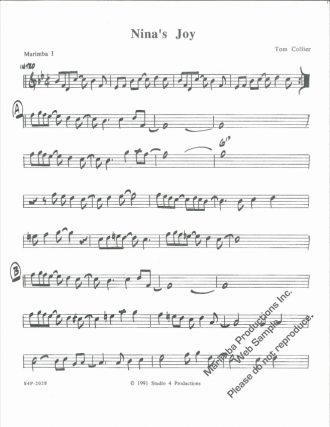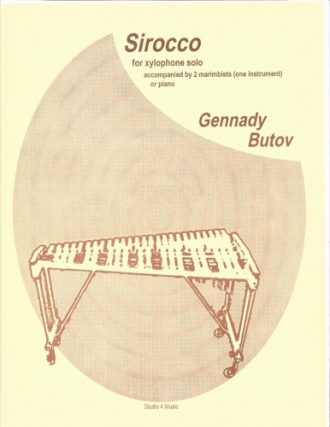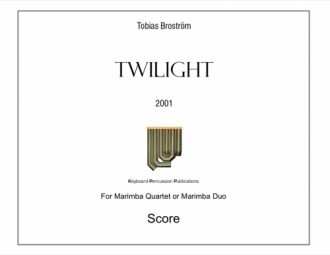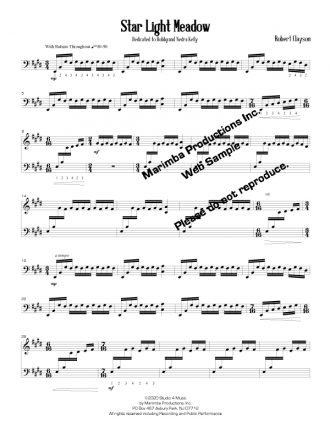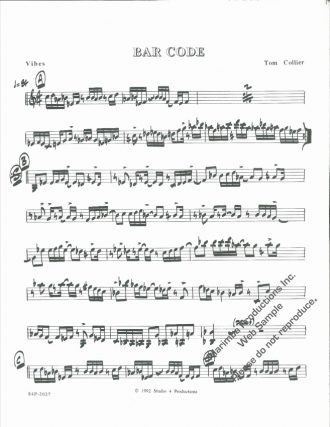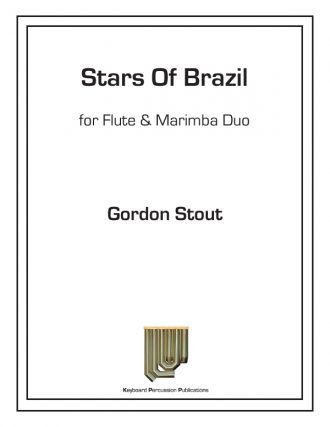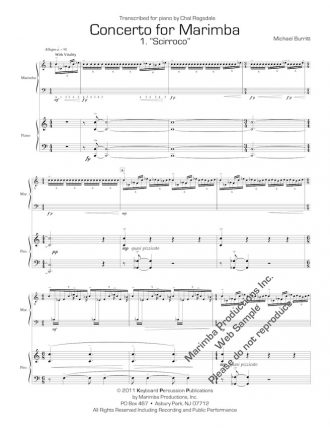One vibraphone, three players, six movements, 15 minutes … I must admit this didn’t seem enticing at first; however Jonathan Kolm creates some very nice moments by utilizing various performance techniques.
The composer gives the option to perform with three players on different instruments, which I highly suggest. This makes it much more idiomatic for the performers (especially regarding space), and it gives them all access to a pedal; this will lead to a much more successful performance. All parts may be played with two mallets, but by using three instruments, the performers have the option to use four mallets.
The various techniques involved include striking the resonators and bars with the shaft of the mallet, scraping the bars with triangle beaters, pitch bending, increasing/decreasing motor speed and glissandi. These greatly add to the overall appeal of the work when Kolm creates very nice contrasts in color.
Programmatcially, Kolm borrows imagery from two sources: Samuel Taylor Coleridge’s seven-part poem The Rime of the Ancient Mariner and Disney’s film, Pirates of the Caribbean. The related “storyline” is a bit over the top, but I imagine it works well for younger audiences.
While I do not expect this work to gain mass popularity, I can respect the composer’s willingness to think “outside of the box.” The selected techniques create wonderful changes in timbre and definitely provide a much-needed contrast for the ear of the listener..
— Jason Baker, Percussive Notes — November 2012
$40.00
Warrior from the Deep
One vibraphone, three players, six movements, 15 minutes … I must admit this didn’t seem enticing at first; however Jonathan Kolm creates some very nice moments by utilizing various performance techniques. The selected techniques create wonderful changes in timbre and definitely provide a much-needed contrast for the ear of the listener.
– Jason Baker, Percussive Notes
Lights of the Forest
$66.00Lights of the Forest is a loosely programmatic piece. It is inspired by a series of images of light in a forest: the setting sun through the trees, a campfire of a traveler, the glowing eyes of a predator, the glow of bioluminescent life forms, stars peering through the boreal canopy, first light as night recedes.”I really enjoyed this piece for its complexity of techniques, orchestration, and level of difficulty.”-Percussive Notes
Lights of the Forest is a loosely programmatic piece. It is inspired by a series of images of light in a forest: the setting sun through the trees, a campfire of a traveler, the glowing eyes of a predator, the glow of bioluminescent life forms, stars peering through the boreal canopy, first light as night recedes.”I really enjoyed this piece for its complexity of techniques, orchestration, and level of difficulty.”-Percussive Notes
| Difficulty | Advanced |
|---|---|
| Performance Type | Chamber |
Related products
Wrist Twisters
$32.00A classic method book for snare drum, written by Elden “Buster” Bailey, who was a 40+ year member of the New York Philharmonic, a 20+ year teacher at the Juilliard School, and is acclaimed as one of the greatest snare drummers and snare drum teachers of all time.
A classic method book for snare drum, written by Elden “Buster” Bailey, who was a 40+ year member of the New York Philharmonic, a 20+ year teacher at the Juilliard School, and is acclaimed as one of the greatest snare drummers and snare drum teachers of all time.
Method of Movement
$35.00The most detailed text ever written on the subject of four mallet playing. 15 chapters covering grip, strokes, shifts, tone production, interval changes, efficient movement around the instrument.
The most detailed text ever written on the subject of four mallet playing. 15 chapters covering grip, strokes, shifts, tone production, interval changes, efficient movement around the instrument.
Sirocco
$12.00Another delightful piece of Butov’s for xylophone solo, accompanied by two marimbists playing one marimba. Piano accompaniment/score included.
Another delightful piece of Butov’s for xylophone solo, accompanied by two marimbists playing one marimba. Piano accompaniment/score included.
Twilight
$40.00In Twilight, Brostrom focuses on basic ideas of chords and color transformation. An example of this occurs in the opening phrase as chords are passed off from duo to duo. “Twilight” is defined as “the light from the sky between full night and sunrise or between sunset and full night” or simply as “an intermediate state that is not clearly defined.” (Intermediate to Advanced)Duration 6:00.
In Twilight, Brostrom focuses on basic ideas of chords and color transformation. An example of this occurs in the opening phrase as chords are passed off from duo to duo. “Twilight” is defined as “the light from the sky between full night and sunrise or between sunset and full night” or simply as “an intermediate state that is not clearly defined.” (Intermediate to Advanced)Duration 6:00.
Star Light Meadow
$11.00 – $13.00An intermediate solo marimba piece, reminiscent of a summer sunset in the country.
An intermediate solo marimba piece, reminiscent of a summer sunset in the country.
Vertical River
$30.00 – $35.00Inspired by Tyson’s rafting adventure with John Parks on the Boise River. This piece depicts the beauty, excitement, and occasional feeling of losing control that they experienced in the raft that day.
Inspired by Tyson’s rafting adventure with John Parks on the Boise River. This piece depicts the beauty, excitement, and occasional feeling of losing control that they experienced in the raft that day.
Stars of Brazil
$40.00 – $46.00A duo for flute and 5.0-octave marimba.
A duo for flute and 5.0-octave marimba.
Skylark Orange Circles
$33.00 – $39.00Duet for two marimbasSkylark Orange Circles is dedicated to the wonderful Japanese marimba virtuoso, Momoko Kamiya. The music is very dance-like in quality, going over and over through mostly the same sequence of harmonies while melodic variations are developed. The melodic ideas become more and more like a bird (or flute) singing as the work progresses.
Duet for two marimbasSkylark Orange Circles is dedicated to the wonderful Japanese marimba virtuoso, Momoko Kamiya. The music is very dance-like in quality, going over and over through mostly the same sequence of harmonies while melodic variations are developed. The melodic ideas become more and more like a bird (or flute) singing as the work progresses.












